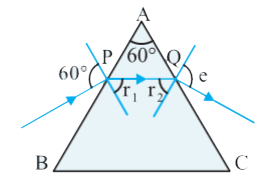Two plane wavefronts of light, one incident on a thin convex lens and another on the refracting face of a thin prism. After refraction at them, the emerging wavefronts respectively become
plane wacefront and plane wavefront
palne wavefront and spherical wavefront
spherical wavefront and plane wavefront
spherical wavefront and spherical wavefront
The correct Answer is:B
Two plane wavefronts of light one incident on a thin convex lens and another on the refracting face of a thin prism. After refraction at the two surfaces, the emerging wave respectively have spherical wavefronts and plane wavefronts are shown in the diagrams (a) and (b).

Similar Questions
A plane wavefront is incident normally on a convex lens. Sketch the reflected wavefront emerging from the lens.
View Solution(i) Define term wavefront. State Huygen.s principle.
(ii) consider a plane wavefront incident on a thin convex lens. Draw a proper diagram to show him the incident wavefront traverses throught the lens and after refraction focuses on the focal point of the lens, giving the shape of the emergent wavefront.
(iii) When light travels from a rarer to a denser medium, it loses speed. Does, this loss imply a reduction in energy carried by the light waves.
View Solution
Knowledge Check
When a plane wavefront is incident on a double convex lens, the refracted wavefront is
Aa plane wavefrontBa cylinderical wavefronCa spherical wavefront which is diverging.Da spherical wavefront wavefront which is converging.A ray of light is incident normally on one of the equal faces of a right isosceles prism of refractive index 1.5. The angle between incident and emergent rays is
A45∘B90∘C180∘D0∘The angles of refraction of a very thin prism is 1∘. A light say is incident normally on one of the refracting surface. The ray that ultimately emerges from the first surface, after suffering from the second surface. Makes an angle of 3.32∘ with the normal. the deviation of the ray emerging from the second surface and the refractive index of the material of the prism respectivley, are
A0.66∘,1.66B1.66∘,1.5C1.5∘,1.66D0.66∘,1.5
A ray of light incident normally on the first face of a glass prism of refractive index 1.6 just emerges from the other face. Find the angle of the prism.
View SolutionA ray of light is incident on one face of a prism (m=√3) at an angle of 60∘. The refracting angle of the prism is also 60∘. Find the angle of emergence .

View SolutionA ray of light is incident on one face of a prism (m=√3) at an angle of 60∘. The refracting angle of the prism is also 60∘. Find the angle of emergence .

View SolutionAn isosceles prism has one of the refracting surfaces silvered. A ray of light is incident normally on the refracting face AB. After two reflections, the ray emerges from the base of the prism perpendicular to it. Find the angle of the prism.
View SolutionAn isosceles prism has one of the refracting surfaces silvered. A ray of light is incident normally on the refracting face AB. After two reflections, the ray emerges from the base of the prism perpendicular to it. Find the angle of the prism.
View Solution
